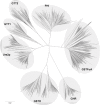Xenomic networks variability and adaptation traits in wood decaying fungi
- PMID: 23279857
- PMCID: PMC3815920
- DOI: 10.1111/1751-7915.12015
Xenomic networks variability and adaptation traits in wood decaying fungi
Abstract
Fungal degradation of wood is mainly restricted to basidiomycetes, these organisms having developed complex oxidative and hydrolytic enzymatic systems. Besides these systems, wood-decaying fungi possess intracellular networks allowing them to deal with the myriad of potential toxic compounds resulting at least in part from wood degradation but also more generally from recalcitrant organic matter degradation. The members of the detoxification pathways constitute the xenome. Generally, they belong to multigenic families such as the cytochrome P450 monooxygenases and the glutathione transferases. Taking advantage of the recent release of numerous genomes of basidiomycetes, we show here that these multigenic families are extended and functionally related in wood-decaying fungi. Furthermore, we postulate that these rapidly evolving multigenic families could reflect the adaptation of these fungi to the diversity of their substrate and provide keys to understand their ecology. This is of particular importance for white biotechnology, this xenome being a putative target for improving degradation properties of these fungi in biomass valorization purposes.
© 2013 The Authors. Published by Society for Applied Microbiology and Blackwell Publishing Ltd. This is an open access article under the terms of the Creative Commons Attribution License, which permits use, distribution and reproduction in any medium, provided the original work is properly cited.
Figures





References
-
- Adamis PD, Gomes DS, Pinto ML, Panek AD, Eleutherio EC. The role of glutathione transferases in cadmium stress. Toxicol Lett. 2004;154:81–88. - PubMed
-
- Asgher M, Bhatti HN, Ashraf M, Legge RL. Recent developments in biodegradation of industrial pollutants by white rot fungi and their enzyme system. Biodegradation. 2008;19:771–783. - PubMed
-
- Bässler C, Müller J, Svoboda M, Lepšová A, Hahn C, Holzer H, Pouska V. Diversity of wood-decaying fungi under different disturbance regimes – a case study from spruce mountain forests. Biodivers Conserv. 2012;21:33–49.
Publication types
MeSH terms
Substances
LinkOut - more resources
Full Text Sources
Other Literature Sources

